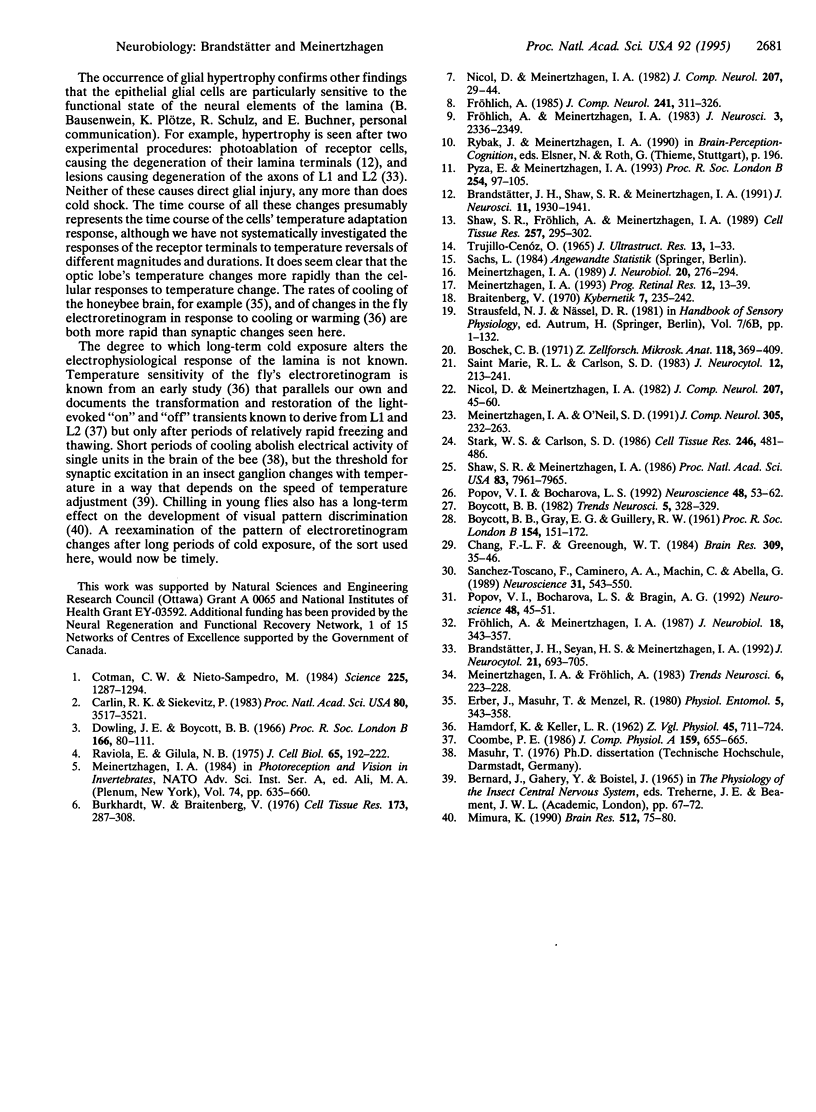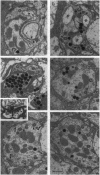Abstract
When a housefly, Musca domestica, is subject to cold exposure (0 degrees C for 24 hr), a number of obvious changes are seen in the first optic neuropil, or lamina, beneath the compound eye. In particular, the number of afferent photoreceptor synapses declines by about 30%. This loss is dramatically restored after warm recovery at 23 degrees C for 24 hr. Synapses disappear at an average rate of 2-3/hr during cold exposure and reappear at a maximal rate of more than 20/hr during the first 2 hr of warm recovery. Thereafter their number temporarily overshoots control values, to increase at 6 hr of warm recovery to 60% above their cold-exposed minimum. The number subsequently returns more or less to normal. These changes demonstrate the lability of synaptic sites under these conditions, with individual sites forming and disappearing rapidly. The changes also interrupt the close correlation between synaptic number and the surface area of the receptor terminal, a correlation that normally conserves synaptic spacing density. The density is preserved during cold exposure but increases during warm recovery at a time when the addition of newly formed synapses exceeds the slower increase in receptor terminal size.
Full text
PDF




Images in this article
Selected References
These references are in PubMed. This may not be the complete list of references from this article.
- Boschek C. B. On the fine structure of the peripheral retina and lamina ganglionaris of the fly, Musca domestica. Z Zellforsch Mikrosk Anat. 1971;118(3):369–409. doi: 10.1007/BF00331193. [DOI] [PubMed] [Google Scholar]
- Braitenberg V. Ordnung und Orientierung der Elemente im Sehsystem der Fliege. Kybernetik. 1970 Dec;7(6):235–242. [PubMed] [Google Scholar]
- Brandstätter J. H., Seyan H. S., Meinertzhagen I. A. The effects of the loss of target cells upon photoreceptor inputs in the fly's optic lobe. J Neurocytol. 1992 Oct;21(10):693–705. doi: 10.1007/BF01181585. [DOI] [PubMed] [Google Scholar]
- Brandstätter J. H., Shaw S. R., Meinertzhagen I. A. Terminal degeneration and synaptic disassembly following receptor photoablation in the retina of the fly's compound eye. J Neurosci. 1991 Jul;11(7):1930–1941. doi: 10.1523/JNEUROSCI.11-07-01930.1991. [DOI] [PMC free article] [PubMed] [Google Scholar]
- Burkhardt W., Braitenberg V. Some peculiar synaptic complexes in the first visual ganglion of the fly, Musca domestica. Cell Tissue Res. 1976 Oct 13;173(3):287–308. doi: 10.1007/BF00220317. [DOI] [PubMed] [Google Scholar]
- Carlin R. K., Siekevitz P. Plasticity in the central nervous system: do synapses divide? Proc Natl Acad Sci U S A. 1983 Jun;80(11):3517–3521. doi: 10.1073/pnas.80.11.3517. [DOI] [PMC free article] [PubMed] [Google Scholar]
- Chang F. L., Greenough W. T. Transient and enduring morphological correlates of synaptic activity and efficacy change in the rat hippocampal slice. Brain Res. 1984 Aug 20;309(1):35–46. doi: 10.1016/0006-8993(84)91008-4. [DOI] [PubMed] [Google Scholar]
- Cotman C. W., Nieto-Sampedro M. Cell biology of synaptic plasticity. Science. 1984 Sep 21;225(4668):1287–1294. doi: 10.1126/science.6382610. [DOI] [PubMed] [Google Scholar]
- Dowling J. E., Boycott B. B. Organization of the primate retina: electron microscopy. Proc R Soc Lond B Biol Sci. 1966 Nov 15;166(1002):80–111. doi: 10.1098/rspb.1966.0086. [DOI] [PubMed] [Google Scholar]
- Fröhlich A. Freeze-fracture study of an invertebrate multiple-contact synapse: the fly photoreceptor tetrad. J Comp Neurol. 1985 Nov 15;241(3):311–326. doi: 10.1002/cne.902410306. [DOI] [PubMed] [Google Scholar]
- Fröhlich A., Meinertzhagen I. A. Quantitative features of synapse formation in the fly's visual system. I. The presynaptic photoreceptor terminal. J Neurosci. 1983 Nov;3(11):2336–2349. doi: 10.1523/JNEUROSCI.03-11-02336.1983. [DOI] [PMC free article] [PubMed] [Google Scholar]
- Fröhlich A., Meinertzhagen I. A. Regulation of synaptic frequency: comparison of the effects of hypoinnervation with those of hyperinnervation in the fly's compound eye. J Neurobiol. 1987 Jul;18(4):343–357. doi: 10.1002/neu.480180403. [DOI] [PubMed] [Google Scholar]
- Meinertzhagen I. A. Fly photoreceptor synapses: their development, evolution, and plasticity. J Neurobiol. 1989 Jul;20(5):276–294. doi: 10.1002/neu.480200503. [DOI] [PubMed] [Google Scholar]
- Meinertzhagen I. A., O'Neil S. D. Synaptic organization of columnar elements in the lamina of the wild type in Drosophila melanogaster. J Comp Neurol. 1991 Mar 8;305(2):232–263. doi: 10.1002/cne.903050206. [DOI] [PubMed] [Google Scholar]
- Mimura K. Developmental process of visual pattern discrimination in the fly. Brain Res. 1990 Mar 26;512(1):75–80. doi: 10.1016/0006-8993(90)91172-d. [DOI] [PubMed] [Google Scholar]
- Nicol D., Meinertzhagen I. A. An analysis of the number and composition of the synaptic populations formed by photoreceptors of the fly. J Comp Neurol. 1982 May 1;207(1):29–44. doi: 10.1002/cne.902070104. [DOI] [PubMed] [Google Scholar]
- Nicol D., Meinertzhagen I. A. Regulation in the number of fly photoreceptor synapses: the effects of alterations in the number of presynaptic cells. J Comp Neurol. 1982 May 1;207(1):45–60. doi: 10.1002/cne.902070105. [DOI] [PubMed] [Google Scholar]
- Popov V. I., Bocharova L. S., Bragin A. G. Repeated changes of dendritic morphology in the hippocampus of ground squirrels in the course of hibernation. Neuroscience. 1992;48(1):45–51. doi: 10.1016/0306-4522(92)90336-z. [DOI] [PubMed] [Google Scholar]
- Popov V. I., Bocharova L. S. Hibernation-induced structural changes in synaptic contacts between mossy fibres and hippocampal pyramidal neurons. Neuroscience. 1992;48(1):53–62. doi: 10.1016/0306-4522(92)90337-2. [DOI] [PubMed] [Google Scholar]
- Pyza E., Meinertzhagen I. A. Daily and circadian rhythms of synaptic frequency in the first visual neuropile of the housefly's (Musca domestica L.) optic lobe. Proc Biol Sci. 1993 Nov 22;254(1340):97–105. doi: 10.1098/rspb.1993.0133. [DOI] [PubMed] [Google Scholar]
- Raviola E., Gilula N. B. Intramembrane organization of specialized contacts in the outer plexiform layer of the retina. A freeze-fracture study in monkeys and rabbits. J Cell Biol. 1975 Apr;65(1):192–222. doi: 10.1083/jcb.65.1.192. [DOI] [PMC free article] [PubMed] [Google Scholar]
- Saint Marie R. L., Carlson S. D. The fine structure of neuroglia in the lamina ganglionaris of the housefly, Musca domestica L. J Neurocytol. 1983 Apr;12(2):213–241. doi: 10.1007/BF01148463. [DOI] [PubMed] [Google Scholar]
- Sanchez-Toscano F., Caminero A. A., Machin C., Abella G. Neuronal plasticity in the hedgehog supraoptic nucleus during hibernation. Neuroscience. 1989;31(2):543–550. doi: 10.1016/0306-4522(89)90396-5. [DOI] [PubMed] [Google Scholar]
- Shaw S. R., Fröhlich A., Meinertzhagen I. A. Direct connections between the R7/8 and R1-6 photoreceptor subsystems in the dipteran visual system. Cell Tissue Res. 1989 Aug;257(2):295–302. doi: 10.1007/BF00261833. [DOI] [PubMed] [Google Scholar]
- Shaw S. R., Meinertzhagen I. A. Evolutionary progression at synaptic connections made by identified homologous neurones. Proc Natl Acad Sci U S A. 1986 Oct;83(20):7961–7965. doi: 10.1073/pnas.83.20.7961. [DOI] [PMC free article] [PubMed] [Google Scholar]
- Stark W. S., Carlson S. D. Ultrastructure of capitate projections in the optic neuropil of Diptera. Cell Tissue Res. 1986;246(3):481–486. doi: 10.1007/BF00215187. [DOI] [PubMed] [Google Scholar]
- Trujillo-Cenóz O. Some aspects of the structural organization of the intermediate retina of dipterans. J Ultrastruct Res. 1965 Aug;13(1):1–33. doi: 10.1016/s0022-5320(65)80086-7. [DOI] [PubMed] [Google Scholar]




